Evaluating Annual Maximum and Partial Duration Series for Estimating Frequency of Small Magnitude Floods
Abstract
:1. Introduction
2. Materials and Method
2.1. Study Area
2.2. Data
2.3. Flood Series
2.4. Flood Indicators
2.5. Variability Analysis
2.6. Frequency Analysis
3. Results
3.1. Historical Floods
3.2. Frequency Distribution Models
3.3. Frequency of Small Floods
3.4. Monthly Flood Frequency
4. Discussion
5. Conclusions
Acknowledgments
Author Contributions
Conflicts of Interest
References
- The National Flood Risk Advisory Group. Flood risk management in Australia, National Flood Risk Advisory Group (NFRAG). Aust. J. Emerg. Manag. 2008, 23, 21–27. [Google Scholar]
- Luo, P.; He, B.; Takara, K.; Xiong, Y.E.; Nover, D.; Duan, W.; Fukushi, K. Historical assessment of Chinese and Japanese flood management policies and implications for managing future floods. Environ. Sci. Policy 2015, 48, 265–277. [Google Scholar] [CrossRef]
- Markus, M.; Demissie, M. Predictability of annual sediment loads based on flood events. J. Hydrol. Eng. 2006, 11, 354–361. [Google Scholar] [CrossRef]
- Junk, W.J.; Bayley, P.B.; Sparks, R.E. The flood pulse concept in river-floodplain systems. Can. Spec. Publ. Fish. Aquat. Sci. 1989, 106, 110–127. [Google Scholar]
- Tockner, K.; Malard, F.; Ward, J.V. An extension of the flood pulse concept. Hydrol. Process. 2000, 14, 2861–2883. [Google Scholar]
- Bunn, S.E.; Arthington, A.H. Basic principles and ecological consequences of altered flow regimes for aquatic biodiversity. Environ. Manag. 2002, 30, 492–507. [Google Scholar] [CrossRef]
- Godfrey, P.C.; Arthington, A.H.; Pearson, R.G.; Karim, F.; Wallace, J. Fish larvae and recruitment patterns in floodplain lagoons of the Australian Wet Tropics. Mar. Freshw. Res. 2016, 68, 964–979. [Google Scholar] [CrossRef]
- Karim, F.; Petheram, C.; Marvanek, S.; Ticehurst, C.; Wallace, J.; Hasan, M. Impact of climate change on floodplain inundation and hydrological connectivity between wetlands and rivers in a tropical river catchment. Hydrol. Process. 2016, 30, 1574–1593. [Google Scholar] [CrossRef]
- Bendix, J. Flood disturbance and the distribution of riparian species diversity. Geogr. Rev. 1997, 87, 468–483. [Google Scholar] [CrossRef]
- Poff, N.L. Ecological response to and management of increased flooding caused by climate change. Philos. Trans. R. Soc. Lond. 2002, 360, 1497–1510. [Google Scholar] [CrossRef] [PubMed]
- Arthington, A.H.; Godfrey, P.C.; Pearson, R.G.; Karim, F.; Wallace, J. Biodiversity values of remnant freshwater floodplain lagoons in agricultural catchments: Evidence for fish of the wet tropics bioregion, northern Australia. Aquat. Conserv. Mar. Freshw. Ecosyst. 2014, 25, 336–352. [Google Scholar] [CrossRef]
- Hu, G.-M.; Ding, R.-X.; Li, Y.-B.; Shan, J.-F.; Yu, X.-T.; Feng, W. Role of flood discharge in shaping stream geometry: Analysis of a small modern stream in the Uinta Basin, USA. J. Palaeogeogr. 2017, 6, 84–95. [Google Scholar] [CrossRef]
- Rustomji, P.; Bennett, N.; Chiew, F. Flood variability east of Australia’s Great Dividing Range. J. Hydrol. 2009, 374, 196–208. [Google Scholar] [CrossRef]
- Keast, D.; Ellison, J. Magnitude frequency analysis of small floods using the annual and partial series. Water 2013, 5, 1816–1829. [Google Scholar] [CrossRef]
- Zaman, M.A.; Rahman, A.; Haddad, K. Regional flood frequency analysis in arid regions: A case study for Australia. J. Hydrol. 2012, 475, 74–83. [Google Scholar] [CrossRef]
- Petrow, T.; Merz, B. Trends in flood magnitude, frequency and seasonality in Germany in the period 1951–2002. J. Hydrol. 2009, 371, 129–141. [Google Scholar] [CrossRef]
- Bacova-Mitkova, V.; Onderka, M. Analysis of extreme hydrological events on the Danube using the peak over threshold method. J. Hydrol. Hydromech. 2010, 58, 88–101. [Google Scholar] [CrossRef]
- Armstrong, W.H.; Collins, M.J.; Snyder, N.P. Increased frequency of low-magnitude floods in New England. J. Am. Water Resour. Assoc. 2012, 48, 306–320. [Google Scholar] [CrossRef]
- Ball, J.; Babister, M.; Nathan, R.; Weeks, W.; Weinmann, E.; Retallick, M.; Testoni, I. Australian Rainfall and Runoff: A Guide to Flood Estimation; Commonwealth of Australia: Canberra, Australia, 2016. [Google Scholar]
- Adamowski, K.; Liang, G.-C.; Patry, G.G. Annual maxima and partial duration Food series analysis by parametric and non-parametric methods. Hydrol. Process. 1998, 12, 1685–1699. [Google Scholar] [CrossRef]
- Bezak, N.; Brilly, M.; Šraj, M. Comparison between the peaks-over-threshold method and the annual maximum method for flood frequency analysis. Hydrol. Sci. J. 2014, 59, 959–977. [Google Scholar] [CrossRef]
- Beguería, S. Uncertainties in partial duration series modelling of extremes related to the choice of the threshold value. J. Hydrol. 2005, 303, 215–230. [Google Scholar] [CrossRef]
- Lang, M.; Ouarda, T.B.; Bobee, B. Towards operational guidelines for over-threshold modeling. J. Hydrol. 1999, 225, 103–117. [Google Scholar] [CrossRef]
- Great Barrier Reef Marine Park Authority. Population and Major Land Use in the Great Barrier Reef Catchment Area: Spatial and Temporal Trends; Great Barrier Reef Marine Park Authority (GBRMPA): Townsville, Australia, 2001; p. 79.
- Karim, F.; Kinsey-Henderson, A.; Wallace, J.; Godfrey, P.; Arthington, A.H.; Pearson, R.G. Modelling hydrological connectivity of tropical floodplain wetlands via a combined natural and artificial stream network. Hydrol. Process. 2014, 28, 5696–5710. [Google Scholar] [CrossRef]
- Pearson, R.G.; Godfrey, P.C.; Arthington, A.H.; Wallace, J.; Karim, F.; Ellison, M. Biophysical status of remnant freshwater floodplain lagoons in the great barrier reef catchment: A challenge for assessment and monitoring. Mar. Freshw. Res. 2013, 64, 208. [Google Scholar] [CrossRef]
- Hopkins, L.C.; Holland, G.J. Australian heavy-rain days and associated east coast cyclones: 1958–92. J. Clim. 1997, 10, 621–635. [Google Scholar] [CrossRef]
- McBride, J.L.; Nicholls, N. Seasonal relationships between Australian rainfall and the southern oscillation. Mon. Weather Rev. 1983, 111, 1998–2004. [Google Scholar] [CrossRef]
- Alexander, J.; Fielding, C.R.; Pocock, G.D. Flood behaviour of the Burdekin river, tropical north Queensland, Australia. Special Publications. Geol. Soc. Lond. 1999, 163, 27–40. [Google Scholar] [CrossRef]
- Wallace, J.; Karim, F.; Wilkinson, S. Assessing the potential underestimation of sediment and nutrient loads to the Great Barrier Reef lagoon during floods. Mar. Pollut. Bull. 2012, 65, 194–202. [Google Scholar] [CrossRef] [PubMed]
- Rustomji, P. A Statistical Analysis of Flood Hydrology and Bankfull Discharge for the Daly River Catchment, Northern Territory, Australia; Commonwealth Scientific and Industrial Research Organisation: Canberra, Australia, 2009; p. 73. [Google Scholar]
- Erskine, W.D. Erosion and deposition produced by a catastrophic flood on the genoa river, Victoria. Aust. J. Soil Water Conserv. 1993, 6, 35–43. [Google Scholar]
- Gringorten, I.I. A plotting rule for extreme probability paper Journal of Geophysical Research. Oceans 1963, 68, 813–814. [Google Scholar] [CrossRef]
- Pilgrim, D.H.; Doran, D.G. Flood frequency analysis. In Australian Rainfall and Runoff: A Guide to Flood Estimation; Pilgrim, D.H., Ed.; Academic Press: Sydney, Australia, 1987; pp. 197–236. [Google Scholar]
- Rahman, A.S.; Rahman, A.; Zaman, M.A.; Haddad, K.; Ahsan, A.; Imteaz, M. A study on selection of probability distributions for at-site flood frequency analysis in Australia. Nat. Hazards 2013, 69, 1803–1813. [Google Scholar] [CrossRef]
- Vogel, R.M.; Fennessey, N.M. L moment diagrams should replace product moment diagrams. Water Resour. Res. 1993, 29, 1745–1752. [Google Scholar] [CrossRef]
- Vogel, R.M.; McMahon, T.A.; Chiew, F.H.S. Floodflow frequency model selection in Australia. J. Hydrol. 1993, 146, 421–449. [Google Scholar] [CrossRef]
- Gilleland, E.; Katz, R.W. Extremes 2.0: An extreme value analysis package. J. Stat. Softw. 2016, 72, 1–39. [Google Scholar] [CrossRef]
- Wallace, J.; Stewart, L.; Hawdon, A.; Keen, R.; Karim, F.; Kemei, J. Flood water quality and marine sediment and nutrient loads from the Tully and Murray catchments in north Queensland, Australia. Mar. Freshw. Res. 2009, 60, 1123–1131. [Google Scholar] [CrossRef]
- McMahon, T.A.; Finlayson, B.L.; Haines, A.T.; Srikanthan, R. Global Runoff: Continental Comparisons of Annual Flows and Peak Discharges; Catena Verlag: Cremlingen-Destedt, Germany, 1992. [Google Scholar]
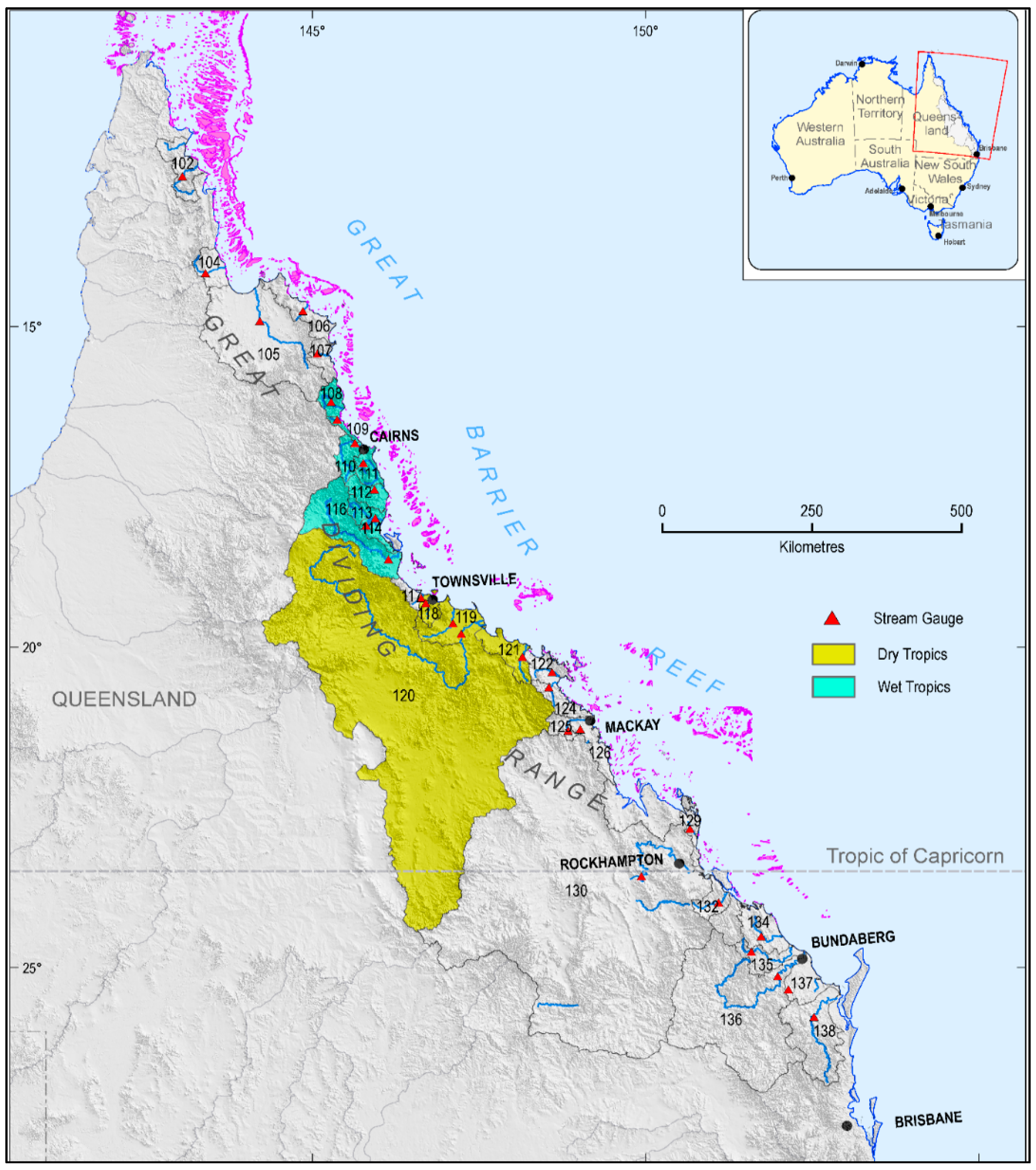


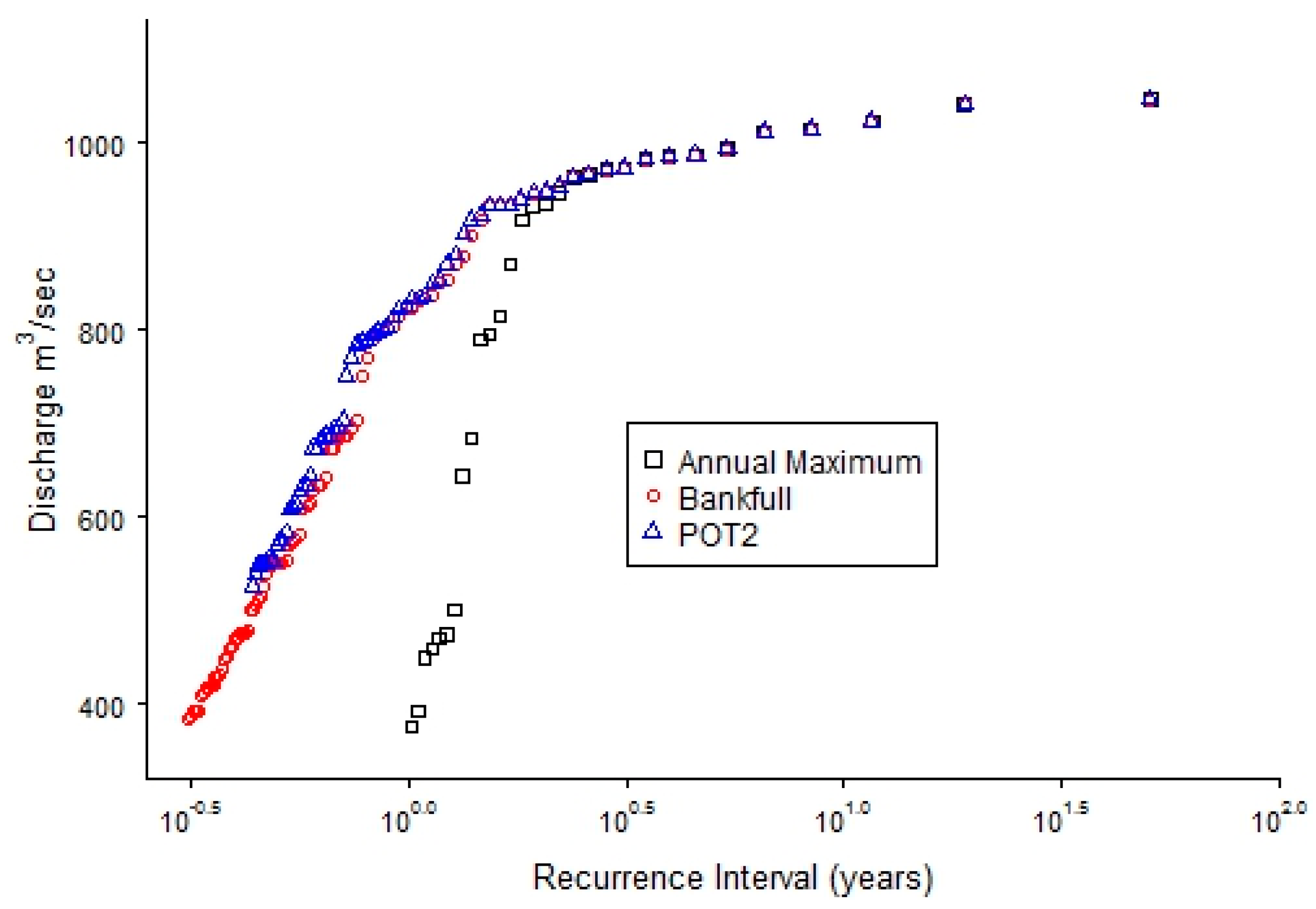
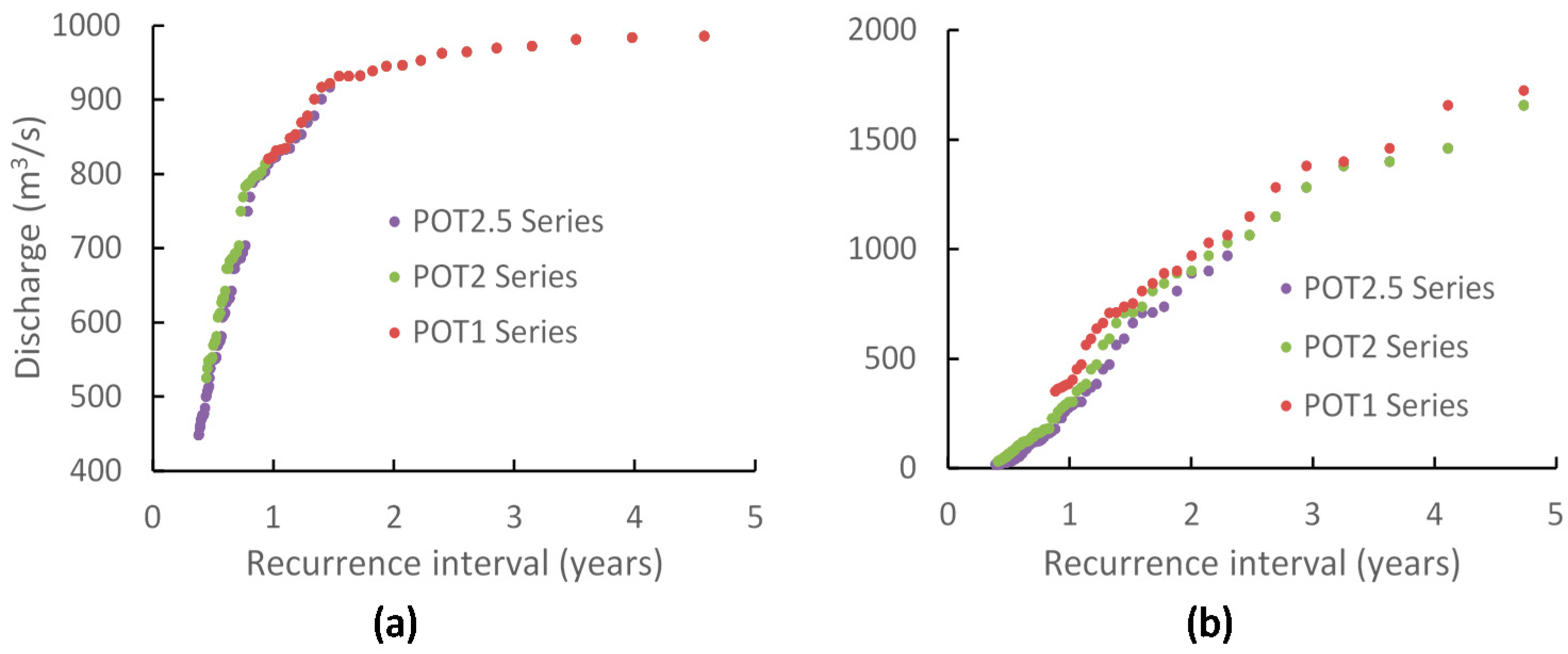

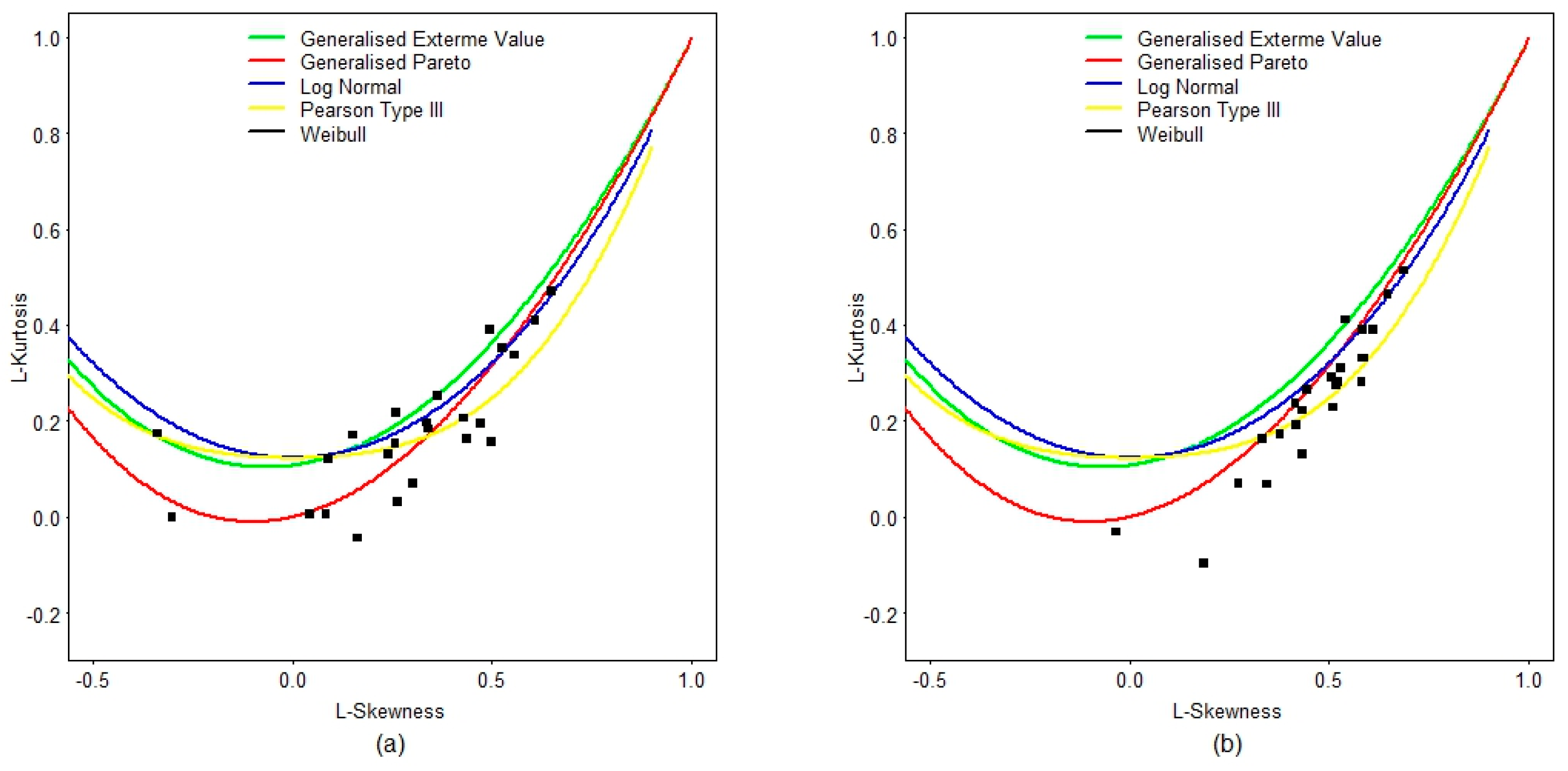
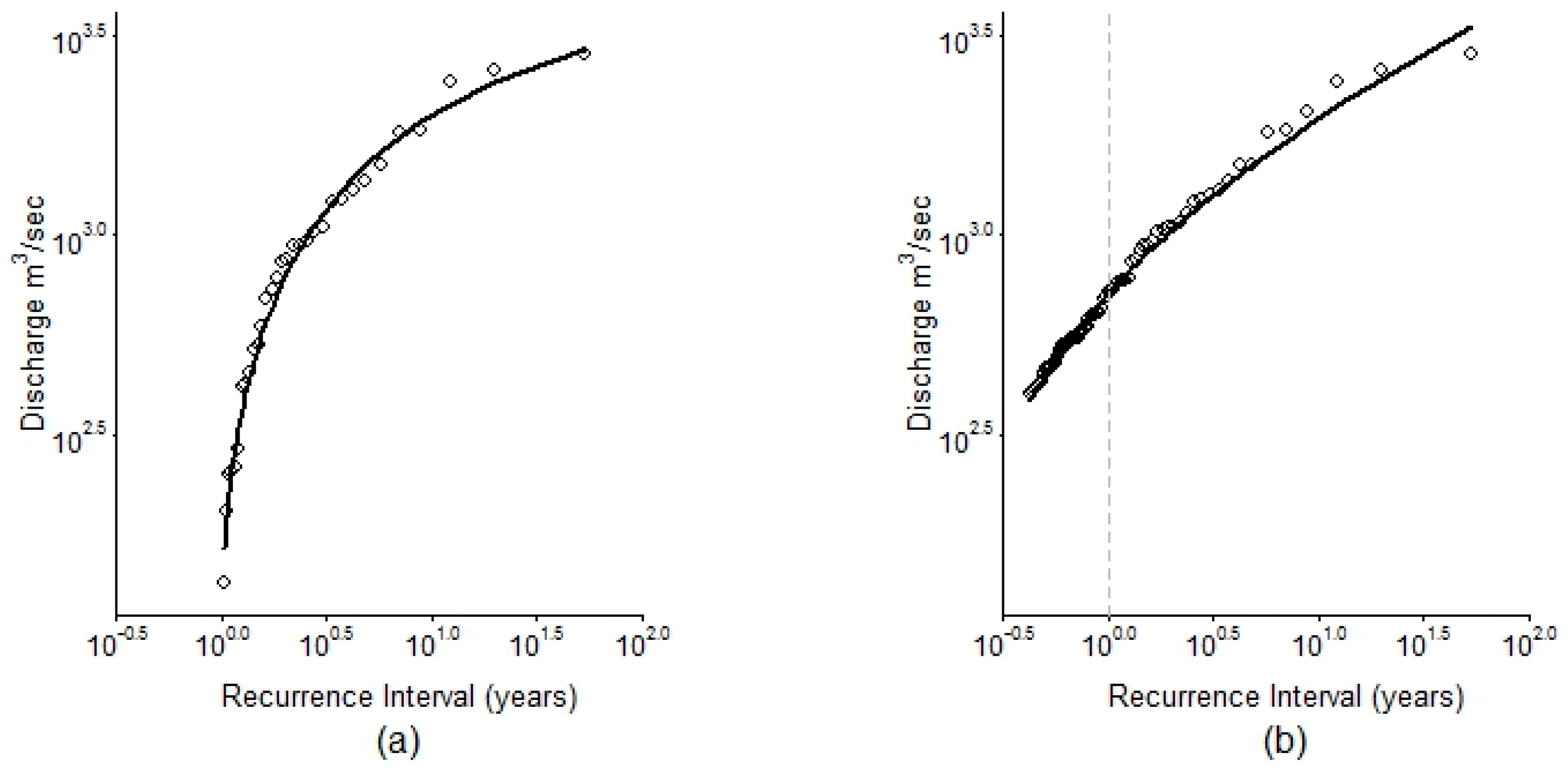
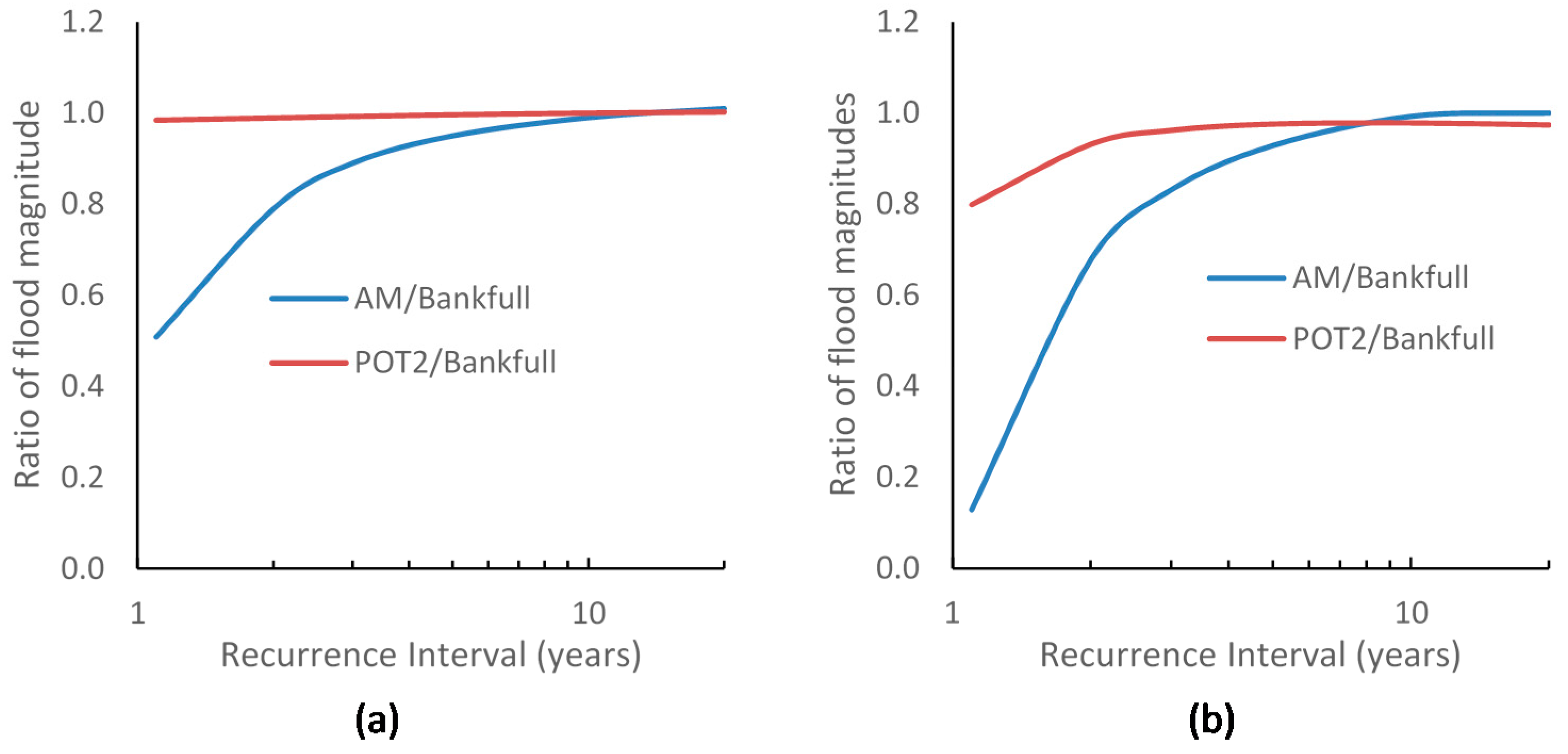
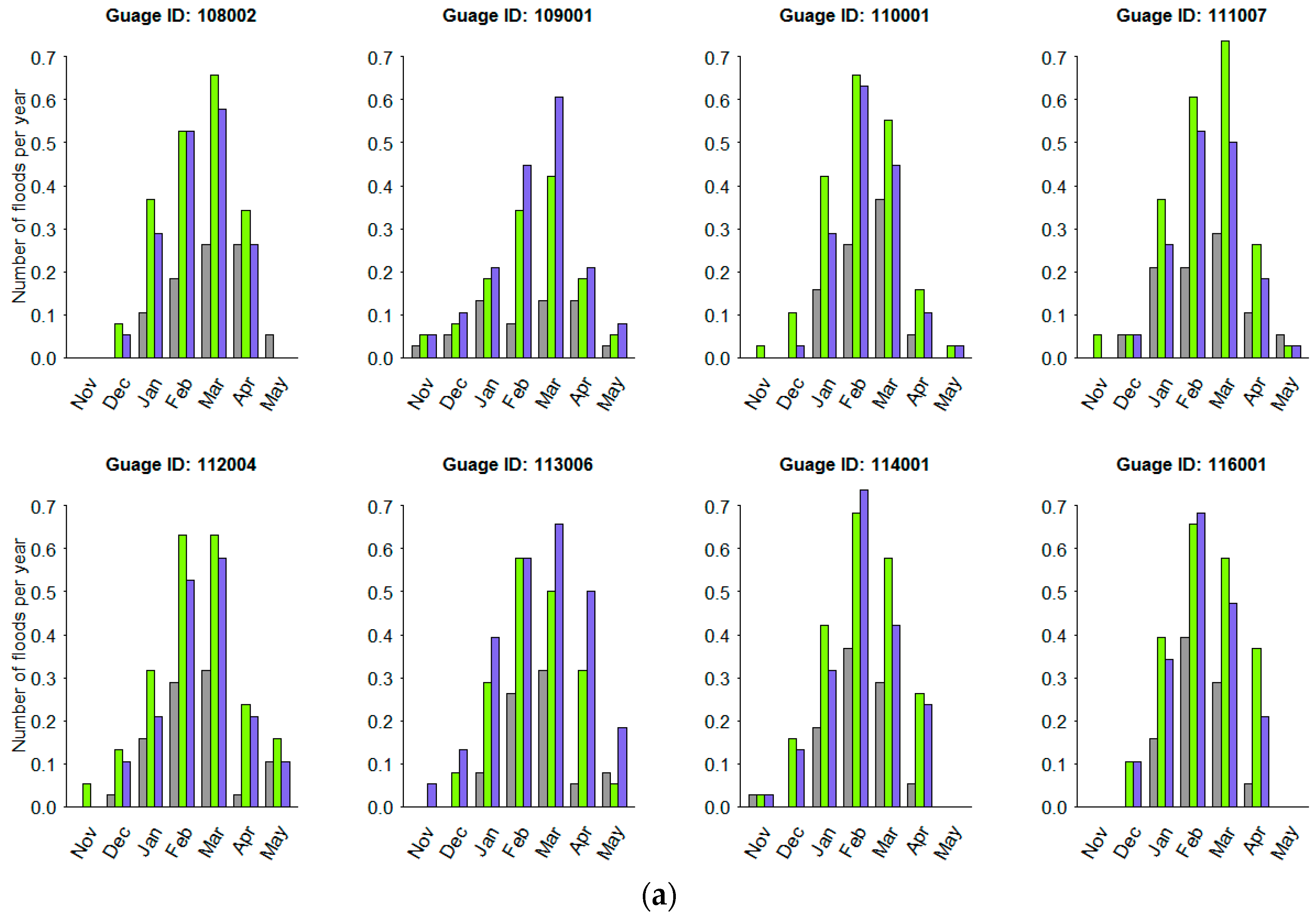
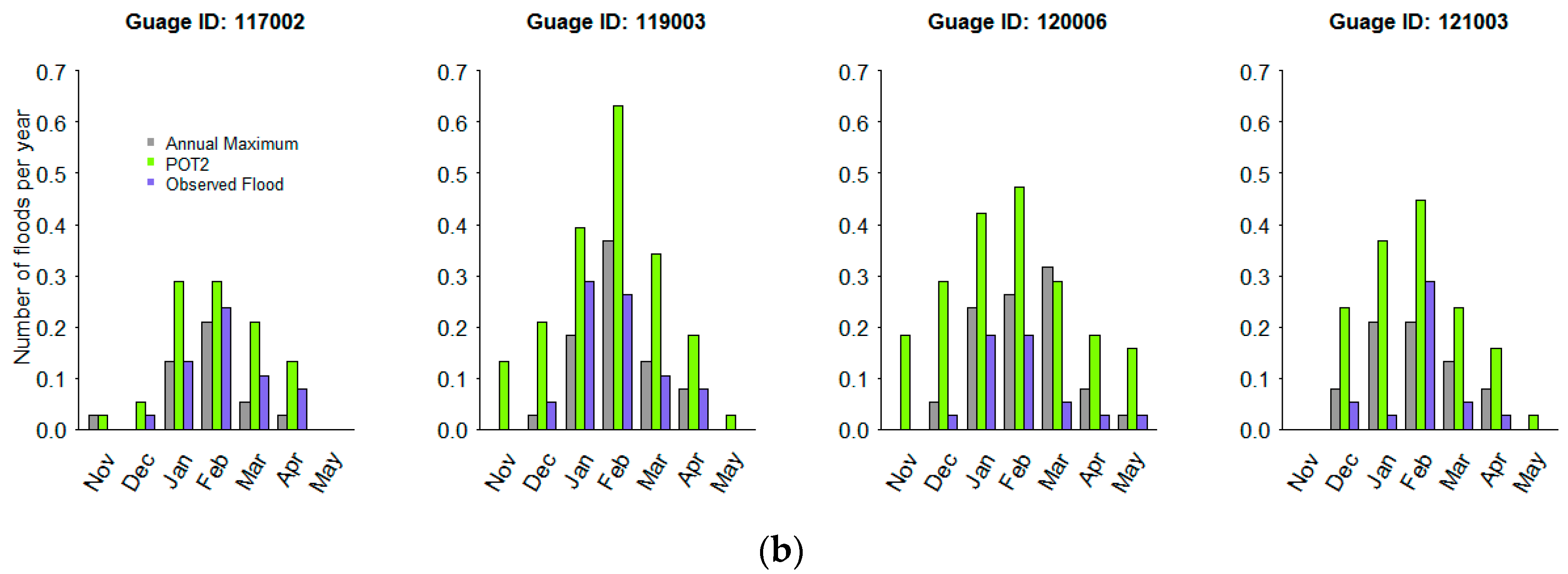
| Indicator | Abbreviation | Description |
|---|---|---|
| Annual maximum streamflow (m3/s) | AMAXF | Maximum of daily flow in a water year (July–June) |
| Peak over threshold flow for one flood per year (m3/s) | POT1F | Discharge magnitude that produces on average one flood per year |
| Peak over threshold flow for two floods per year (m3/s) | POT2F | Discharge magnitude that produces on average two floods per year |
| Peak over threshold flow for 2.5 floods per year (m3/s) | POT2.5F | Discharge magnitude that produces on average 2.5 floods per year |
| Bankfull discharge (m3/s) | BF | Discharge magnitude that initiates a flood |
| Site ID | Gauge | River | Catchment Area (km2) | Data Length (Years) | Bankfull Level (m) | Bankfull Discharge (m3/s) | Historical Floods (per Year) | FFMI |
|---|---|---|---|---|---|---|---|---|
| 102 | 102102 | Pascoe | 4197 | 32 | 8.00 | 514 | 1.72 | 0.36 |
| 104 | 104001 | Stewart | 2679 | 29 | 4.10 | 102 | 1.62 | 0.39 |
| 105 | 105107 | Normanby | 24,624 | 10 | 5.30 | 621 | 1.56 | 0.20 |
| 106 | 106002 | Jeannie | 3577 | 17 | 6.20 | 84 | 1.18 | 0.39 |
| 107 | 107001 | Endeavour | 2065 | 30 | 3.40 | 55 | 1.80 | 0.45 |
| 108 | 108002 | Daintree | 1893 | 33 | 5.80 | 282 | 1.97 | 0.35 |
| 109 | 109001 | Mossman | 533 | 22 | 3.20 | 47 | 3.05 | 0.27 |
| 110 | 110001 | Barron | 2135 | 32 | 3.90 | 251 | 1.81 | 0.45 |
| 111 | 111007 | Mulgrave | 1993 | 35 | 4.40 | 275 | 1.71 | 0.37 |
| 112 | 112004 | Johnstone | 2250 | 35 | 3.80 | 419 | 1.89 | 0.29 |
| 113 | 113006 | Tully | 1590 | 30 | 5.40 | 378 | 3.23 | 0.15 |
| 114 | 114001 | Murray | 1042 | 35 | 5.40 | 43 | 2.03 | 0.35 |
| 116 | 116001 | Herbert | 9742 | 35 | 6.40 | 765 | 2.03 | 0.37 |
| 117 | 117002 | Black | 1046 | 18 | 1.50 | 110 | 1.28 | 0.39 |
| 119 | 119003 | Haughton | 4353 | 31 | 4.10 | 417 | 1.00 | 0.78 |
| 120 | 120006 | Burdekin | 130,044 | 35 | 8.50 | 5592 | 0.54 | 0.77 |
| 121 | 121003 | Don | 3538 | 28 | 2.20 | 71 | 0.64 | 0.61 |
| 129 | 129001 | Waterpark | 1629 | 35 | 4.00 | 74 | 0.63 | 0.74 |
| 130 | 130003 | Fitzroy | 142,460 | 30 | 13.60 | 3180 | 0.47 | 0.65 |
| 132 | 132001 | Calliope | 2175 | 34 | 8.40 | 250 | 0.82 | 0.88 |
| 134 | 134001 | Baffle | 3970 | 32 | 9.00 | 299 | 0.81 | 0.74 |
| 135 | 135002 | Kolan | 2904 | 26 | 3.40 | 67 | 0.96 | 0.91 |
| 136 | 136001 | Burnett | 33,274 | 18 | 9.40 | 1552 | 0.33 | 0.65 |
| 138 | 138014 | Mary | 9450 | 33 | 5.10 | 1149 | 0.73 | 0.73 |
| Region | Number of Gauges | Mean FFMI | Reference |
|---|---|---|---|
| World rivers | 931 | 0.28 | McMahon et al. [40] |
| Australian and southern African rivers | 280 | 0.45 | McMahon et al. [40] |
| Rest of the world rivers | 651 | 0.21 | McMahon et al. [40] |
| Hunter Valley, NSW | 24 | 0.65 | Erskine [32] |
| GBR lagoon catchments | 24 | 0.51 | Present study |
| Wet tropical catchments | 8 | 0.35 | Present study |
| Gauge | Bankfull | Total Floods | Floods above Bankfull | ||||
|---|---|---|---|---|---|---|---|
| Floods | POT1 | POT2 | POT2.5 | POT1 | POT2 | POT2.5 | |
| 102102 | 55 | 32 | 63 | 80 | 32 | 55 | 54 |
| 107001 | 54 | 30 | 60 | 75 | 30 | 53 | 53 |
| 113006 | 97 | 30 | 60 | 75 | 30 | 60 | 75 |
| 121003 | 18 | 28 | 56 | 71 | 15 | 13 | 12 |
| 130003 | 14 | 30 | 60 | 75 | 14 | 13 | 12 |
| 135002 | 25 | 26 | 52 | 65 | 25 | 23 | 15 |
| 138014 | 24 | 33 | 66 | 82 | 24 | 22 | 21 |
| Gauge | Flood Series | Average Recurrence Interval (Years) | |||||
|---|---|---|---|---|---|---|---|
| 1 | 2 | 3 | 5 | 10 | 20 | ||
| 102102 | AM | 320 | 784 | 1122 | 1515 | 1993 | 2414 |
| POT | 785 | 1056 | 1279 | 1571 | 1988 | 2429 | |
| 104001 | AM | 80 | 151 | 217 | 312 | 469 | 666 |
| POT | 156 | 190 | 225 | 283 | 395 | 562 | |
| 105107 | AM | 910 | 1801 | 1972 | 2028 | 2041 | 2043 |
| POT | 1048 | 1838 | 1939 | 2034 | 2071 | 2080 | |
| 106002 | AM | 49 | 117 | 173 | 245 | 347 | 454 |
| POT | 127 | 181 | 225 | 283 | 364 | 448 | |
| 107001 | AM | 38 | 98 | 146 | 208 | 291 | 376 |
| POT | 85 | 122 | 156 | 203 | 277 | 363 | |
| 108002 | AM | 262 | 654 | 934 | 1253 | 1630 | 1953 |
| POT | 566 | 805 | 996 | 1237 | 1567 | 1899 | |
| 109001 | AM | 81 | 153 | 206 | 267 | 343 | 409 |
| POT | 134 | 173 | 206 | 251 | 321 | 399 | |
| 110001 | AM | 229 | 628 | 947 | 1351 | 1901 | 2456 |
| POT | 525 | 788 | 1017 | 1332 | 1814 | 2365 | |
| 111007 | AM | 238 | 620 | 843 | 1051 | 1240 | 1359 |
| POT | 511 | 694 | 838 | 1015 | 1251 | 1481 | |
| 112004 | AM | 390 | 841 | 1128 | 1420 | 1717 | 1931 |
| POT | 762 | 964 | 1130 | 1347 | 1655 | 1980 | |
| 113006 | AM | 541 | 907 | 988 | 1018 | 1027 | 1028 |
| POT | 867 | 948 | 982 | 1006 | 1021 | 1027 | |
| 114001 | AM | 52 | 166 | 228 | 281 | 325 | 350 |
| POT | 123 | 193 | 237 | 278 | 319 | 346 | |
| 116001 | AM | 683 | 2649 | 4097 | 5790 | 7874 | 9736 |
| POT | 1662 | 3303 | 4538 | 6013 | 7879 | 9600 | |
| 117002 | AM | 63 | 200 | 280 | 353 | 418 | 459 |
| POT | 158 | 232 | 284 | 340 | 405 | 458 | |
| 119003 | AM | 75 | 693 | 1095 | 1510 | 1943 | 2263 |
| POT | 466 | 954 | 1267 | 1586 | 1915 | 2153 | |
| 120006 | AM | 361 | 3340 | 5628 | 8416 | 12,040 | 15,488 |
| POT | 1087 | 3677 | 5729 | 8311 | 11,805 | 15,291 | |
| 121003 | AM | 13 | 39 | 65 | 109 | 193 | 319 |
| POT | 33 | 57 | 82 | 123 | 201 | 318 | |
| 129001 | AM | 4 | 35 | 63 | 103 | 168 | 246 |
| POT | 40 | 67 | 92 | 126 | 181 | 246 | |
| 130003 | AM | 530 | 2196 | 3655 | 5685 | 8824 | 12,469 |
| POT | 1438 | 3031 | 4412 | 6316 | 9222 | 12,550 | |
| 132001 | AM | 25 | 243 | 433 | 695 | 1095 | 1555 |
| POT | 234 | 429 | 597 | 830 | 1185 | 1592 | |
| 134001 | AM | 49 | 236 | 412 | 676 | 1126 | 1710 |
| POT | 231 | 384 | 531 | 754 | 1146 | 1670 | |
| 135002 | AM | 11 | 81 | 151 | 263 | 471 | 766 |
| POT | 71 | 136 | 201 | 306 | 500 | 777 | |
| 136001 | AM | 80 | 511 | 909 | 1494 | 2463 | 3683 |
| POT | 405 | 927 | 1371 | 1970 | 2861 | 3850 | |
| 138014 | AM | 214 | 865 | 1494 | 2458 | 4151 | 6427 |
| POT | 877 | 1607 | 2287 | 3295 | 4988 | 7151 | |
| Average Recurrence Interval (Years) | |||||||
|---|---|---|---|---|---|---|---|
| Distribution | Percentiles | 1 | 2 | 3 | 5 | 10 | 20 |
| GEV | 10th | 0.34 | 0.66 | 0.77 | 0.86 | 0.94 | 0.96 |
| 50th | 0.50 | 0.82 | 0.93 | 0.99 | 1.01 | 1.02 | |
| 90th | 0.70 | 0.92 | 0.98 | 1.03 | 1.05 | 1.06 | |
| GPA | 10th | 0.31 | 0.65 | 0.77 | 0.87 | 0.95 | 0.94 |
| 50th | 0.44 | 0.81 | 0.94 | 1.00 | 1.01 | 1.01 | |
| 90th | 0.66 | 0.94 | 1.01 | 1.05 | 1.05 | 1.05 | |
| LP3 | 10th | 0.30 | 0.60 | 0.78 | 0.88 | 0.96 | 0.97 |
| 50th | 0.49 | 0.83 | 0.93 | 0.98 | 1.00 | 1.00 | |
| 90th | 0.70 | 0.93 | 1.01 | 1.02 | 1.02 | 1.02 | |
© 2017 by the authors. Licensee MDPI, Basel, Switzerland. This article is an open access article distributed under the terms and conditions of the Creative Commons Attribution (CC BY) license (http://creativecommons.org/licenses/by/4.0/).
Share and Cite
Karim, F.; Hasan, M.; Marvanek, S. Evaluating Annual Maximum and Partial Duration Series for Estimating Frequency of Small Magnitude Floods. Water 2017, 9, 481. https://doi.org/10.3390/w9070481
Karim F, Hasan M, Marvanek S. Evaluating Annual Maximum and Partial Duration Series for Estimating Frequency of Small Magnitude Floods. Water. 2017; 9(7):481. https://doi.org/10.3390/w9070481
Chicago/Turabian StyleKarim, Fazlul, Masud Hasan, and Steve Marvanek. 2017. "Evaluating Annual Maximum and Partial Duration Series for Estimating Frequency of Small Magnitude Floods" Water 9, no. 7: 481. https://doi.org/10.3390/w9070481





